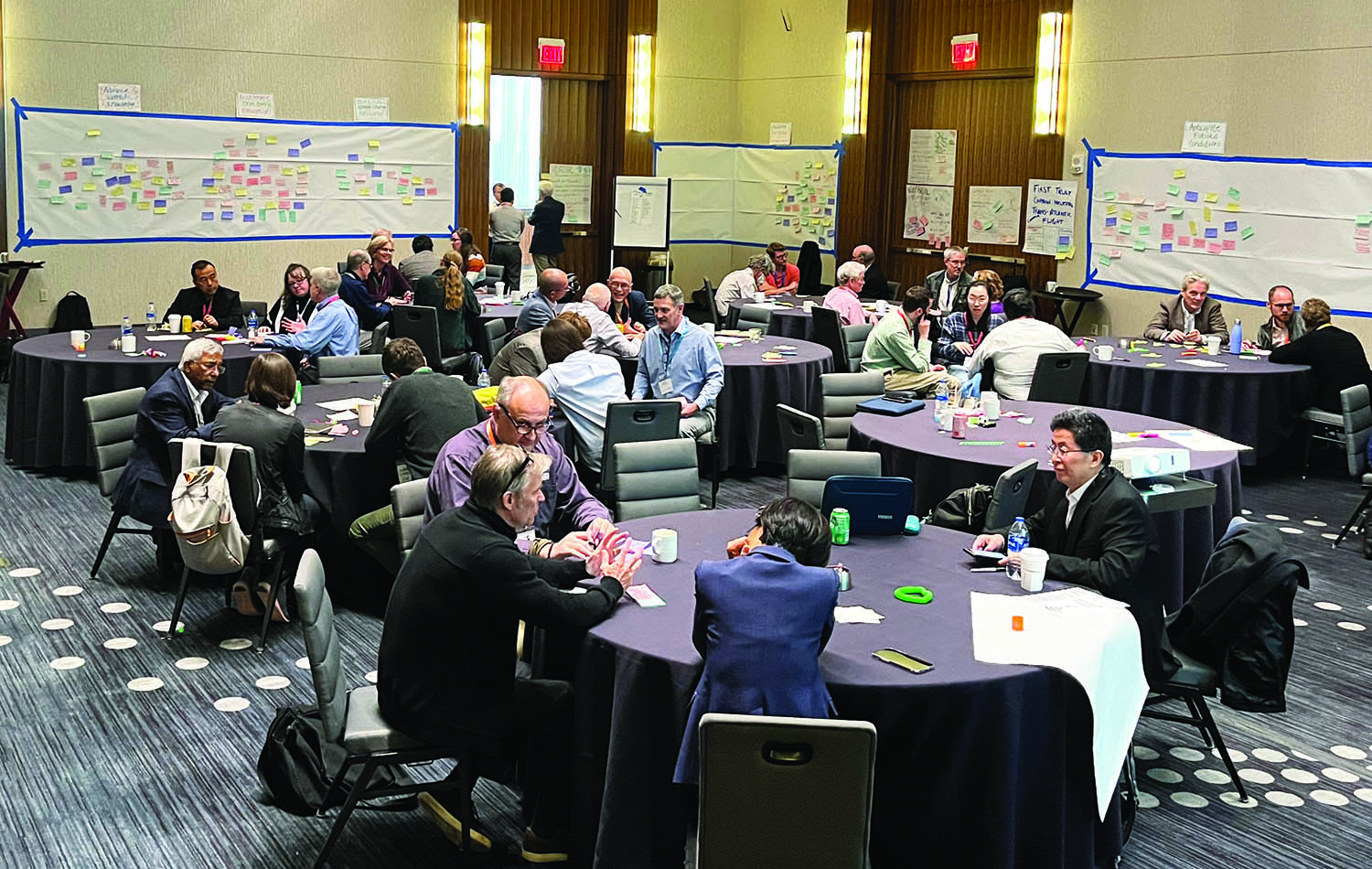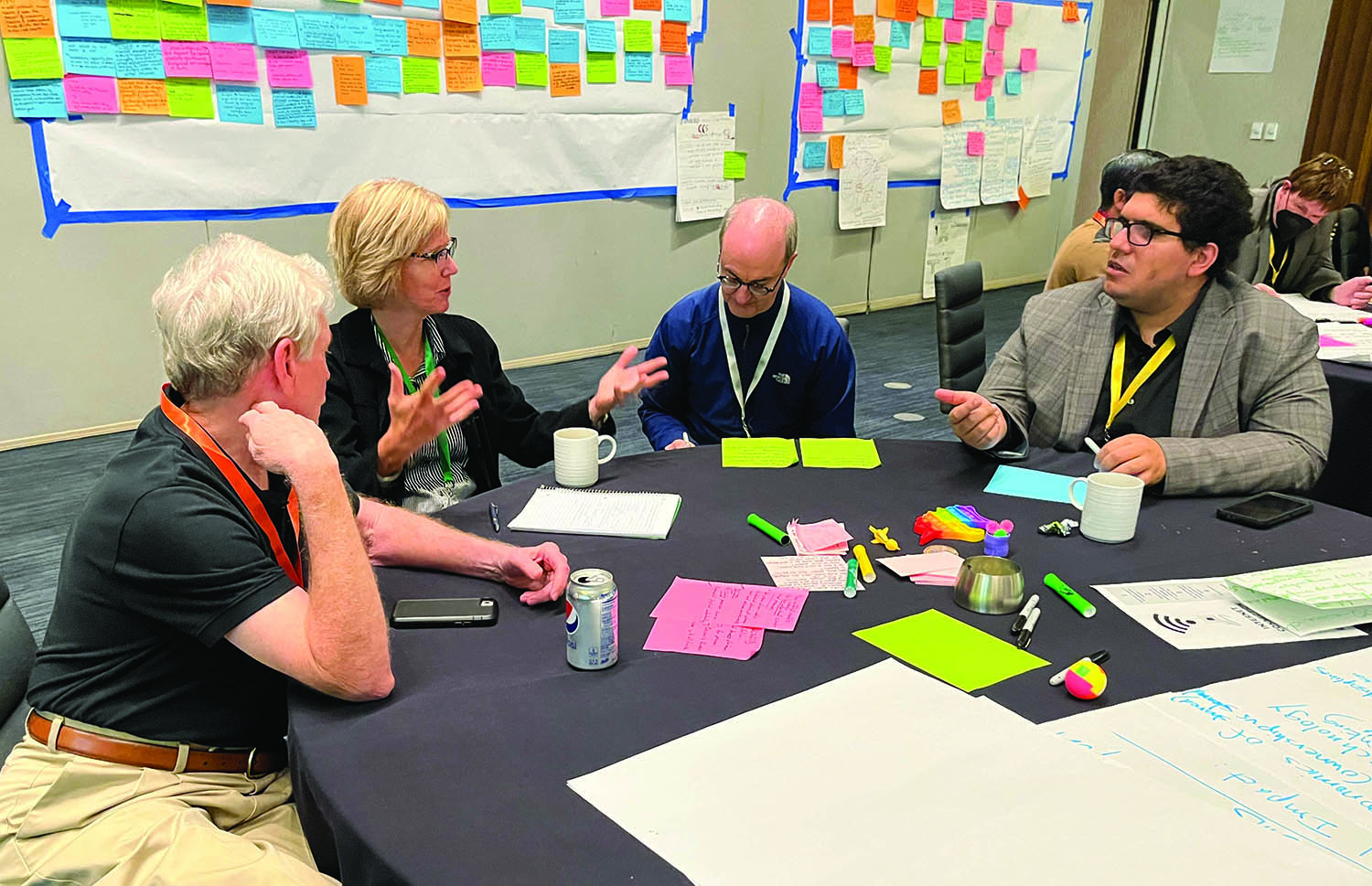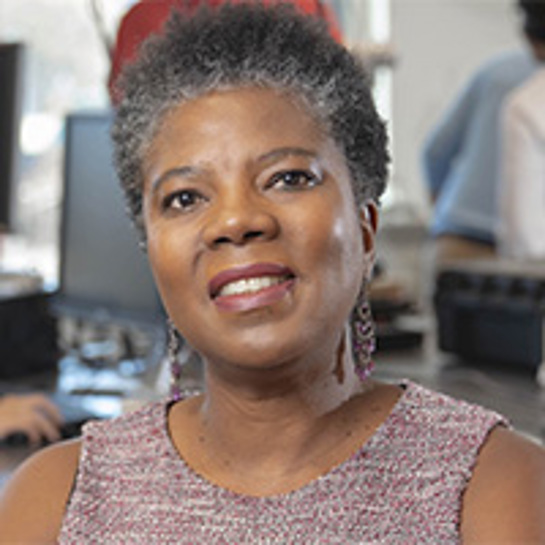SIAM Convenes Researchers to Envision a Sustainable and Resilient Future
“World Removes More Carbon Than It Produces for the First Time!”
“Net Negative: Significant Reduction in Greenhouse Gases Through Math!”
“First Truly Carbon Neutral Transatlantic Commercial Flight!”
“The Missing Link Filled — Battery Technology Breakthrough Allows 100 Percent Renewable National Grid!”
These eye-catching predictions are examples of the bold, future-looking news headlines that participants generated at the SIAM Convening on Climate Science, Sustainability, and Clean Energy. The three-day workshop—which took place in Tyson’s Corner, Va., in October 2022—was SIAM’s response to the U.S. National Science Foundation’s (NSF) call to action on Critical Aspects of Sustainability: Innovative Solutions to Climate Change, which encouraged “science and engineering communities to develop forward-thinking research that will demonstrably aid in the Nation’s goal of reaching net-zero greenhouse gas emissions and developing approaches for adapting to the change that is already occurring.” The SIAM workshop was funded by NSF Division of Mathematical Sciences (DMS) grant 2227218.
In 2021, the SIAM Climate Task Force—an offshoot of SIAM’s Committee on Science Policy—produced a report titled “Research and Education Priorities to Address Climate Change, Boost Environmental Resilience, and Advance Clean Energy” [1]. That report came from the SIAM viewpoint, but there was also a need to engage an even broader group of researchers and stakeholders. For the convening, SIAM therefore recruited participants from outside of SIAM membership — and even some who were unfamiliar with the Society.
Suzanne Weekes, SIAM’s Executive Director, assembled a multidisciplinary steering committee that worked closely with Annemarie Boss of KnowInnovation (KI) and Annie Imperatrice, Senior Assistant to the Executive Director at SIAM, to plan the workshop. KI is an organization that facilitates discussion and idea generation to guide and accelerate academic, scientific, and interdisciplinary innovation. Ultimately, more than 55 researchers from academia, industry, nonprofit organizations, and government research laboratories came together to articulate challenges, recognize problems, and identify foundational long-term research and workforce needs that would benefit from federal investment. These researchers included social and economic scientists, atmospheric scientists and geoscientists, physical scientists, and mathematical scientists and engineers. The consequent deliverable of the convening—with additional work by a subset of attendees after the event—was a comprehensive report that describes major challenges, themes, and recommendations. It is helpful for decision makers to hear directly from researchers and important that they have recommendations in hand when determining investment directions.

On the first day of the meeting, DMS Division Director David Manderscheid and DMS Deputy Division Director Junping Wang addressed the participants. Jody Reimer, an assistant professor in the Department of Mathematics and School of Biological Sciences at the University of Utah, then delivered a call to action on behalf of the convening’s steering committee. Reimer displayed some impactful images and shared current news headlines that answered the question, “Why are we here at this workshop?” She challenged attendees to consider how society might take ambitious interdisciplinary leaps towards net-zero emissions, sustainability, climate change mitigation and adaptation, food security, and climate equity and justice. In addition, Reimer framed the convening as an opportunity to (i) expand the range of actionable scientific research, (ii) broaden the participation of scientists, policymakers, and communities, (iii) quickly and strategically identify solutions to pressing problems, and (iv) contribute to an exciting future of human flourishing. She explained that at present, scientific communities often pursue small, incremental steps at too slow a pace; remain siloed within their disciplines; and fail to tackle complex problems holistically.
KI facilitators kept attendees’ brains and bodies active with engaging and energizing activities. Participants moved beyond their research comfort zones; effectively collaborated with members of distinct fields; and quickly became accustomed to the acronym “WIBGI” (pronounced wib-ghee), which stands for “Wouldn’t It Be Great If [aspiration] by doing [approach].” Throughout the workshop, attendees posted WIBGIs on the wall and organized them into “Mild,” “Medium,” and “Spicy” categories. The “Spicy” WIBGIs eventually yielded nine recommendations for federal research and development agencies. More information about these recommendations is available in the final report, and short presentations that explore each topic are accessible via SIAM’s YouTube Channel.
Recommendations: The Big Ideas
The nine recommendations aim to advance scientific knowledge, anticipate future conditions, accelerate clean energy innovations and sustainable practices, and increase resilience in the face of climate change. Here, we briefly explore the key points of each recommendation.
As climate systems continue to change more rapidly than scientists had originally anticipated, we must develop a multi-fidelity, open-source, scalable platform that serves as a digital twin for planet Earth. By ingesting new data and updating model information in real time, this twin would provide characterization and forecasting in the presence of uncertainty — ultimately leading to new scientific insights and informing policy decisions.
Water crises in multiple regions of the U.S.—and indeed across the entire globe—highlight the difficulty of ensuring access to this vital resource. Existing systems are becoming defunct, and climate change has impacted both the availability and overabundance of water. The creation of a nationwide smart water grid could distribute water more efficiently and improve the resilience of our country’s water infrastructure. Engineering solutions must be coupled with water access models and economic analyses to guarantee the equitable sharing of this basic human need.
Extreme weather events are increasingly making headlines around the world and leaving devastation in their wakes. Such disasters, which are visible effects of a changing climate, necessitate the development of new learning tools that accurately model, characterize, and predict extreme events. Classification of the various types of extreme weather requires more data collection and additional input from meteorological subject matter experts. Data analysis demands novel algorithms to better quantify the likelihood of these events—which occur in the tails of frequency distributions—in the presence of nonstationary behavior.
Scientists often view climate events as cascading consequences of the dynamics of Arctic systems. The loss of sea ice and thawing of Arctic permafrost are signature indicators of planetary warming; however, we do not fully understand the ways in which small-scale effects control the large-scale mechanisms in this region of the Earth. The difficulty and expense that are associated with experimental data collection further exacerbate these challenges and prevent significant progress. Researchers could use mathematical constructs to fill these knowledge gaps.

Local and community-based efforts can ensure sustainability as a priority area. It is therefore important to connect research teams with community stakeholders to identify vulnerabilities and increase resiliency in human and ecological systems. Decision makers and local stakeholders could employ high-resolution models of climate, social, ecological, and economic systems to enact policies that allow communities to adapt to and mitigate climate change vulnerabilities. Connecting multiple layers of the decision process ensures that the most effective strategies are identified and targeted.
Another option for community stakeholder involvement is the introduction of new data analysis approaches that empower local decision making on climate mitigation. The development and application of metrics for data streams—as well as the formation of networks that connect data to decisions—would provide decision confidence and reduce dependence on anecdotal evidence or misused facts. Local decision makers and community leaders could use mathematically sound metrics (designed for public understanding) to quantify and prioritize solutions and incentivize behaviors that enhance sustainability initiatives. Such programs would require the integrated involvement of mathematical, computational, social, behavioral, and political scientists at research centers throughout the U.S.
Discussions about sustainability initiatives also focused on the creation of a circular economy. Novel carbon-free production methods and materials must ultimately replace petroleum-reliant and/or petroleum-derived manufacturing and output, and allow for the increased production of novel products. These solutions should span the entire production cycle: reuse, recycle, repurpose, and replace. Research investments in the development and improvement of lifecycle and planning models, optimization and minimization algorithms, consumer behavior data, and community engagement would expedite the eventual shift to a circular economy.
There is also a significant need for accelerated efforts to decarbonize the planet. Larger and broader support from multiple collaborating agencies could build on initial governmental investments and deliver results with urgency. The shift away from fossil fuels will require a functioning green infrastructure that allows for the reduction of energy demands and the transition from fuel-based systems to electricity and renewables. Such an infrastructure would yield numerous benefits, including more green jobs, energy independence, and a cleaner environment.
Connecting all of these ideas is an urgent need to develop the next-generation workforce. Students must be able to place their coursework in a broader context and synthesize concepts to attack complex problems. Instructors should design collaborative approaches to curricula, classes, and pedagogy that cross boundaries among STEM, social science, and other disciplines and graduate thinkers who can contribute to solutions for society’s grand challenges.
Consistent across all nine of these themes is the necessary development of mandatory infrastructure—including both human and capital resources—to enable significant progress. A dedicated effort to bring more voices and experts into all relevant fields is therefore integral, as is funding from multiple agencies that can collectively tackle these interdisciplinary challenges.
Our community is invested in building a sustainable future. The dynamism of the group at the SIAM Convening on Climate Science, Sustainability, and Clean Energy reflected a strong motivation and passion within the diverse STEM community to tackle these difficult problems, and the discussions coalesced into multiple invigorating ideas. The interdisciplinary aspect of the event generated fresh viewpoints, unique collaborations, and transformative initiatives that we hope will germinate and blossom throughout the entire scientific community.
References
[1] Aceves, A., Kaper, H., & Leyffer, S. (2021, October 1). Addressing climate change, boosting environmental resilience, and advancing clean energy: Reflections of the SIAM Climate Task Force. SIAM News, 54(8), p. 12.
About the Authors
Katherine Evans
Computational Sciences and Engineering Division Director, Oak Ridge National Laboratory
Katherine (Kate) Evans is the division director for the Computational Sciences and Engineering Division at Oak Ridge National Laboratory.
Lea Jenkins
Professor, Clemson University
Lea Jenkins is a professor in the School of Mathematical and Statistical Sciences at Clemson University, where she works on modeling and simulation problems with industrial applications. She holds a Ph.D. in mathematics from North Carolina State University and is the Vice President for Education at SIAM.
Suzanne Weekes
Chief Executive Officer, SIAM
Suzanne Weekes is the chief executive officer of SIAM.

Stay Up-to-Date with Email Alerts
Sign up for our monthly newsletter and emails about other topics of your choosing.



